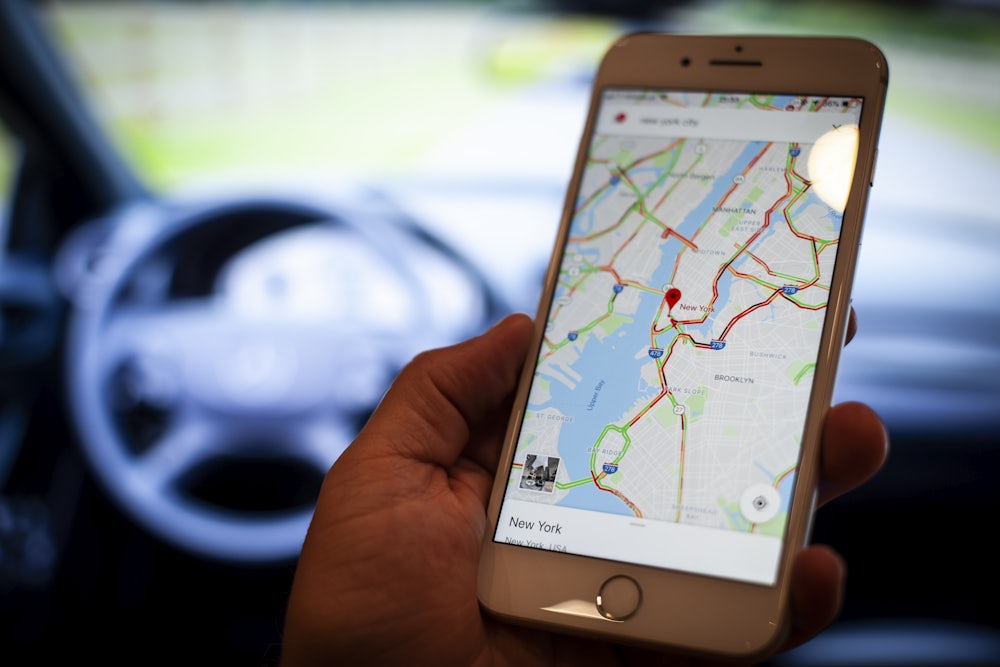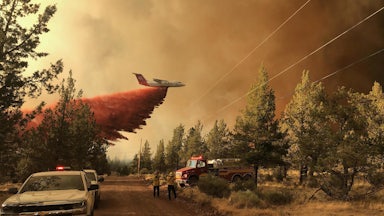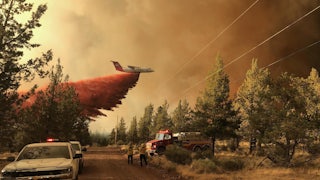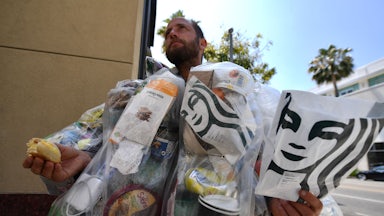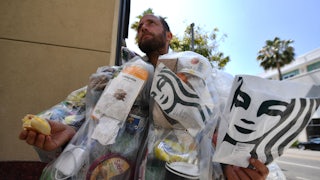A weird paradox of modern life is that, although humans struggle to address big problems like climate change, we’re great at making our lives easier. While the planet has warmed steadily every year since 2000, it’s become exponentially simpler, in the twenty-first century, to get somewhere you’ve never been before, find information on any topic, or order lunch. Some malcontents may gripe that environmental breakdown is itself a huge hassle, but guess what? There’s an app for that too. Silicon Valley can’t fix the climate crisis, but having solved problems like food shopping, these captains of industry now seek to help us avoid the manifold inconveniences of the apocalypse.
Now when you open Google Maps to plan your travels, the app warns you about bad air quality hot spots, as well as floods, wildfires, and hurricanes. The air quality and wildfire warnings are touted as “new” features on the app, although a company spokeswoman told me they were introduced last June.
I write this from Clinton Hill, Brooklyn, where, today, Google Maps tells me the air quality is “acceptable,” though it could pose a “risk for some people, particularly those who are unusually sensitive to air pollution.” That doesn’t seem acceptable to me, but I suppose it’s all relative. A little to the south, in Flatbush, near Farragut Avenue, the map shows a green dot: Air quality there happens to be “good” today, posing no risk to anyone. I’m happy for the people who live or work near the corner of East 26th and Farragut, but there aren’t many other green dots on this map.
There are no wildfires in my area today.
There’s something absurdly dystopian about this, almost like a parody of our information-obsessed, crisis-riddled world. Information, delivered easily through our phones, is supposed to solve all kinds of problems now. Mass shooting? Google has an alert for that. Public transit system underfunded, contributing to planetary collapse? Google tells us how far we can travel by subway and how much it will cost to take a Lyft the rest of the way. I use the app for this often, and when I do, I can sense my anger and stress over insufficient government investment in transit ebbing; as Google seamlessly solves my practical problem, the bigger picture recedes from my view. Apps make us feel like savvy individuals winning at twenty-first-century life. We can do this. We can get to New Jersey. Maybe we can even avoid the pollution if we steer clear of Newark.
Yet who is molding us into these hypervigilant individuals? Companies who are contributing to the crisis. Instead of becoming more adept at navigating climate collapse alone, we need to take collective action to prevent it. Google is not a reliable ally in this project, to say the least.
While Google is hardly the worst corporate climate offender, its operations produce millions of tons of carbon emissions, and in 2019 The Guardian reported that the company had made large contributions to right-wing climate-denier organizations like the Competitive Enterprise Institute, the group that convinced Trump to abandon the Paris Agreement. In the most recent election cycle, Google’s PAC gave more than 40 percent of its House campaign donations to Republicans, a political strategy that anyone serious about preventing climate catastrophe might wish to rethink. And like all big tech companies, Google spends big on lobbying, talks big on climate, but spends only a tiny fraction of its lobbying efforts on climate policy. As recently as last June, Alphabet, Google’s parent company, opposed—and ultimately defeated—a shareholder resolution urging the company to evaluate whether its lobbying activities were aligned with the Paris Agreement’s goal of limiting global warming.
To be fair, the flood warnings, which have been in place since 2018, save lives, as Google points out. It’s obviously better not to drive into lethal weather. And more encouragingly, in the long run, the data Google is gathering to create these warnings can help scientists and community groups who are working to address the crisis. The street-by-street air quality data, Google points out, can help inform solutions; for example, pollution concentrated in a spot where a freeway meets a bridge could inspire a road redesign or a crackdown on speeding in that spot.
Google has also used its technologies to curb emissions, through “eco-routing,” for example, helping users to find travel routes with the lowest possible carbon footprint. These and other serious sustainability measures, including increased use of renewable energy, have come about partly because of pressure from the company’s own workers.
Still, the message these warnings send is a worrying one: The apocalypse is upon us, but here’s an app to help you keep out of its way. The warnings promote a culture of individual invincibility and information obsession. Neither of these qualities will help us stop the climate crisis, and they may even foreclose political solutions: After all, if environmental crisis is something I can reasonably manage in my daily life, why take political action to stop it?
Besides, information will not help everyone, and the implication that it can is dangerous. In this sense, the apps confirm environmental justice activists’ worst fears: that in lieu of curbing emissions, the well-informed, tech-savvy affluent will simply optimize their own lives and pull up the drawbridge while the rest suffer. Many people have no choice but to live in the most toxic parts of town, regardless of what Google says. If you live by a truck depot, or by the Brooklyn-Queens Expressway, you cannot click away the daily assault on your respiratory system. Not everyone can afford to take a cab when the train doesn’t come. This app-based approach to the climate crisis treats survival as a series of consumer choices, but life is more precious than that. It deserves our collective attention.
Most perilously, though, the new Google Maps warnings promote resignation: The climate crisis is happening, and all we can do now is work around it.
